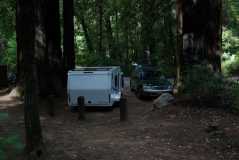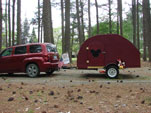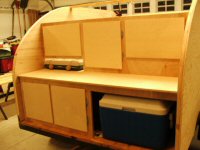Solar Air Conditioning is possible, but requires a big solar panel bank. Your TD trailer will need to be insulated or the power requirements will be prohibitive due to the long run times. You will also need much more solar panel area than your TD can provide on it's roof. Look into making a multi-layer slide out type panel holder. When extended it could also serve as a awning to sit under.

For the fun of it, and to prove it was possible, about 5 years ago I researched how to do solar powered air conditioning for the Micro-RV project. I figured out that I would need 8 * 220W panels to just provide for over night air conditioner use plus a 9th panel for all my other uses. My Micro-RV had just enough roof space to hold 3 of the solar panels. What I mean by over night use is 8 hours of use with a 50% duty cycle on the compressor unit. The most efficient units I could find were 12 or 24 VDC powered units made for the trucking industry for cooling cabs while the drivers sleep. Depending on the company they put 4, 6 or 8 Group 31 deep cycle batteries somewhere on the cab and charged them with a larger alternator while driving. They also rip out the engine driven compressor and air conditioner system and only use the DC powered air conditioner while driving as it uses less energy than an engine mounted compressor would use. Fuel savings from that alone will usually pay for the installation in one to two years on a truck that sees 36 hours a week of OTR driving. Going to 24VDC over 12VDC will likely increase the efficiency of the overall system by 6% to 12%. Not much additional efficiency is seen when going to 36VDC or 48VDC. This efficiency increase is mainly due to less conversion losses when stepping up the battery voltage to the voltage needed to run the compressor, but a significant part also comes from less percentage voltage loss in the wiring. For the Micro-RV project I figured on ripping out the pickup's engine driven air conditioner, and replacing the compressor with a 24VDC 200 Amp alternator. I figured that would recharge the AGM battery bank with only 2 to 3 hours of driving. It would also be used to power the air conditioner while driving.
There are two main mounting methods for the truck mounted sleeper cab units. The most common is just like used for RVs. A roof hatch is installed, and the unit is set on top of it just like how a RV unit is installed. The other style of unit is a split unit. One part goes on the outside back wall of the cab. It has the compressor in it, and the exhaust coils. The other part mounts to the inside of the sleeper cab, and has the interior cooling coils and fan. Between the two parts is a tube pair, and all the units I found had precharged tubes and units where you only needed to hook them up and use. No need for charging the system.
Another thing to look for is the use of a thermal expansion valve for controlling refrigerant flow. Units that use a thermal expansion valve over capillary tubes will be much more efficient over a wider range of temperatures. BTW: if your home system uses capillary tubes, switching to a thermal expansion valve will likely pay for it's self in a year or two.
One issue is do you power a regular 120VAC powered RV air conditioner with power from an inverter, or do you get a purpose built DC powered air conditioner. When I explored things, the regular roof top air conditioners powered by an inverter usually used at least half again more energy to run. I think this was because the units were the only standard RV units and weren't all that efficient. I have since seen much more efficient RV units advertised. On the flip side of this is extra energy use with a regular RV air conditioner you can power it directly from a hookup, or from a generator. If you will be often staying at hookup providing camp grounds that may be the better way to go. If you will most often be boondocking, then it may be better to go with the DC powered units. Another advantage of the DC powered units is they often came in smaller sizes which would be better for a small space like a TD. A TD has a similar amount of space as a sleeper cab has.
Another possible source for a small DC powered air condition units are the ones designed for cooling the cabs of earth mover equipment. Retrofit DC units were made for health and safety reasons, then the industry realized they used less energy than the engine powered units and the rest is history. I never could find a place that would sell me a single unit, but that may have changed. It could be an option for somebody who has an in with the industry.
One option I came up with recently was to put in a relatively large 24VDC battery bank, but not fully rely on it to power the air conditioner. The air conditioner is powered by the battery bank, but a generator is cycled on and off to recharge the battery bank back up to 85% when ever it drops below 50%. For use in NPS campgrounds with generator curfews I figured a second control circuit could be based on a timer to force a recharge of the battery bank before generator curfew, and then keep it off over night. Part of the control circuit would be a switch to switch the air conditioner over to the generator when the generator is running. For me a control unit for this wouldn't be hard to piece together, but then I've built industrial controls...
A side effect of going to solar powered AC is with a little increase in system size it is possible to go to electric appliances like microwave ovens, and induction cook tops for cooking.

Even a convection oven could be run from the battery bank. Lighting loads and the recharging of a cell phones or laptops becomes insignificant. Doing the calculations for air conditioning made me also realize that for weekend use, 2 Group 31 batteries charged up at home would provide more than ample power for a full 3 day weekend getaway even with running a 12VDC powered compressor based cooler. No need for solar or recharging from the vehicle.
Have I overloaded your brain yet?








 Even a convection oven could be run from the battery bank. Lighting loads and the recharging of a cell phones or laptops becomes insignificant. Doing the calculations for air conditioning made me also realize that for weekend use, 2 Group 31 batteries charged up at home would provide more than ample power for a full 3 day weekend getaway even with running a 12VDC powered compressor based cooler. No need for solar or recharging from the vehicle.
Even a convection oven could be run from the battery bank. Lighting loads and the recharging of a cell phones or laptops becomes insignificant. Doing the calculations for air conditioning made me also realize that for weekend use, 2 Group 31 batteries charged up at home would provide more than ample power for a full 3 day weekend getaway even with running a 12VDC powered compressor based cooler. No need for solar or recharging from the vehicle.

